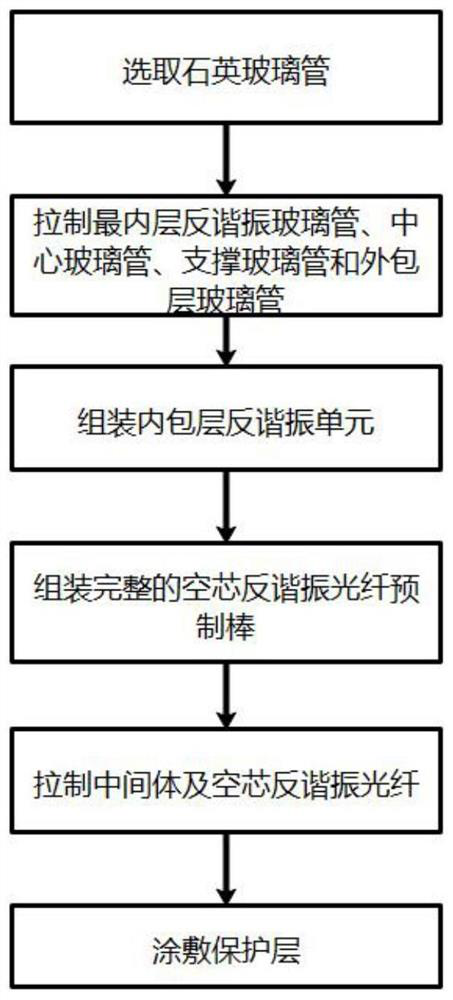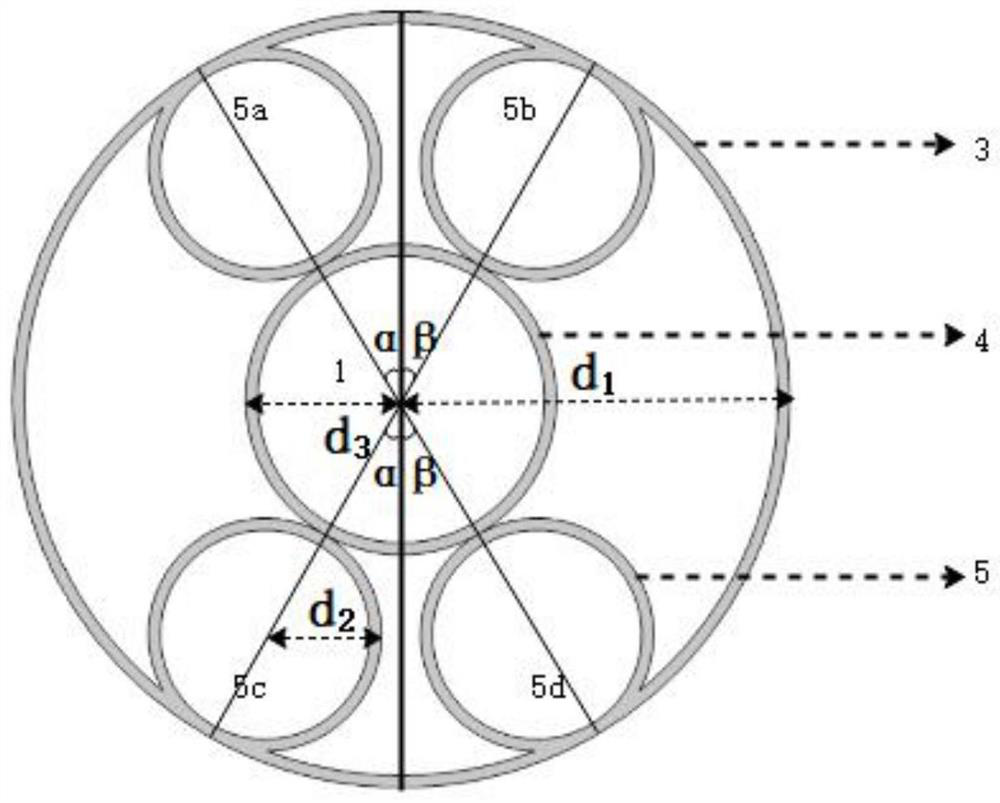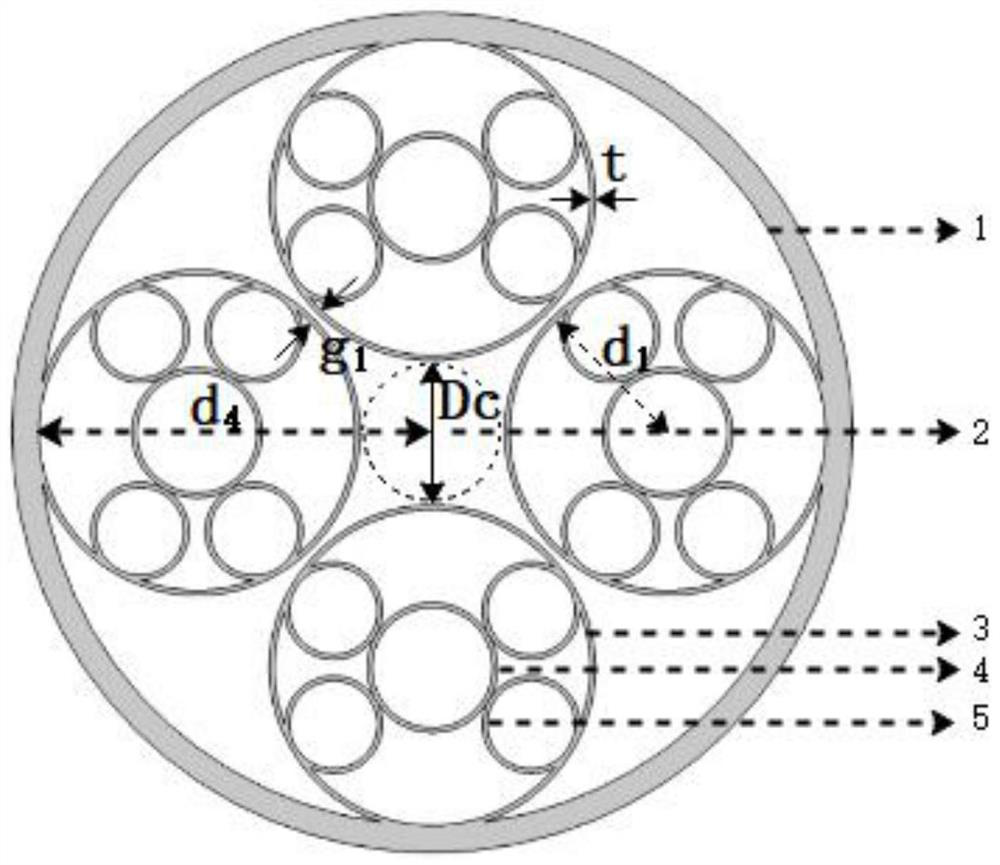Method for manufacturing supporting type hollow-core anti-resonance optical fiber
An anti-resonance, support-type technology, applied in multi-layer core/clad fibers, clad fibers, optics, etc., can solve the problems of collapse and deformation of the clad resonance unit, achieve structural stability, improve collapse and deformation, structure reliable results
- Summary
- Abstract
- Description
- Claims
- Application Information
AI Technical Summary
Problems solved by technology
Method used
Image
Examples
Embodiment 1
[0065] S1, select a quartz glass tube with a refractive index of 1.45 (SiO 2 ) as the material for making the outer cladding and inner cladding of the hollow-core anti-resonant optical fiber, and the innermost anti-resonant glass tubes, central glass tubes, supporting glass tubes and outer cladding glass tubes of different sizes and quantities are drawn respectively:
[0066] S11. Fabricate the innermost anti-resonant glass tube with a radius of 3750 μm and a thickness of 40 μm:
[0067] S111. Determine the radius d of the innermost anti-resonant capillary 3 according to the parameters such as the core diameter, the tube spacing and the number of tubes 1 , the specific expression is as follows:
[0068]
[0069] In the formula, Dc is the diameter of the core area 2, and the value of Dc is 35 μm, g 1 is the tube gap between two adjacent innermost anti-resonance capillaries 3, g 1 The value is taken as 2.7 μm, and N is the number of tubes4.
[0070] S112. The specific exp...
Embodiment 2
[0091] S1, select a quartz glass tube with a refractive index of 1.45 (SiO 2 ) as the material for making the outer cladding and inner cladding of the hollow-core anti-resonant optical fiber, and the innermost anti-resonant glass tubes, central glass tubes, supporting glass tubes and outer cladding glass tubes of different sizes and quantities are drawn respectively:
[0092]S11. Fabricate the innermost anti-resonant glass tube with a radius of 2150 μm and a thickness of 40 μm:
[0093] S111. Determine the radius d of the innermost anti-resonant capillary 3 according to the parameters such as the core diameter, the tube spacing and the number of tubes 1 , the specific expression is as follows:
[0094]
[0095] In the formula, Dc is the diameter of the core area 2, and the value of Dc is 35 μm, g 1 is the tube gap between two adjacent innermost anti-resonance capillaries 3, g 1 The value is 2.7 μm, and N is the number of tubes 5.
[0096] S112. The specific expression o...
Embodiment 3
[0116] S1, select a quartz glass tube with a refractive index of 1.45 (SiO 2 ) as the material for making the outer cladding and inner cladding of the hollow-core anti-resonant optical fiber, and the innermost anti-resonant glass tubes, central glass tubes, support glass tubes, flat glass rods and outer cladding glass tubes are drawn out in different sizes and quantities :
[0117] S11. Fabricate the innermost anti-resonant glass tube with a radius of 3750 μm and a thickness of 40 μm:
[0118] S111. Determine the radius d of the innermost anti-resonant capillary 3 according to the parameters such as the core diameter, the tube spacing and the number of tubes 1 , the specific expression is as follows:
[0119]
[0120] In the formula, Dc is the diameter of the core area 2, and the value of Dc is 35 μm, g 1 is the tube gap between two adjacent innermost anti-resonance capillaries 3, g 1 The value is 2.7 μm, and N is the number of tubes.
[0121] S112. The specific expres...
PUM
| Property | Measurement | Unit |
|---|---|---|
| thickness | aaaaa | aaaaa |
| diameter | aaaaa | aaaaa |
| thickness | aaaaa | aaaaa |
Abstract
Description
Claims
Application Information
 Login to View More
Login to View More - R&D
- Intellectual Property
- Life Sciences
- Materials
- Tech Scout
- Unparalleled Data Quality
- Higher Quality Content
- 60% Fewer Hallucinations
Browse by: Latest US Patents, China's latest patents, Technical Efficacy Thesaurus, Application Domain, Technology Topic, Popular Technical Reports.
© 2025 PatSnap. All rights reserved.Legal|Privacy policy|Modern Slavery Act Transparency Statement|Sitemap|About US| Contact US: help@patsnap.com



